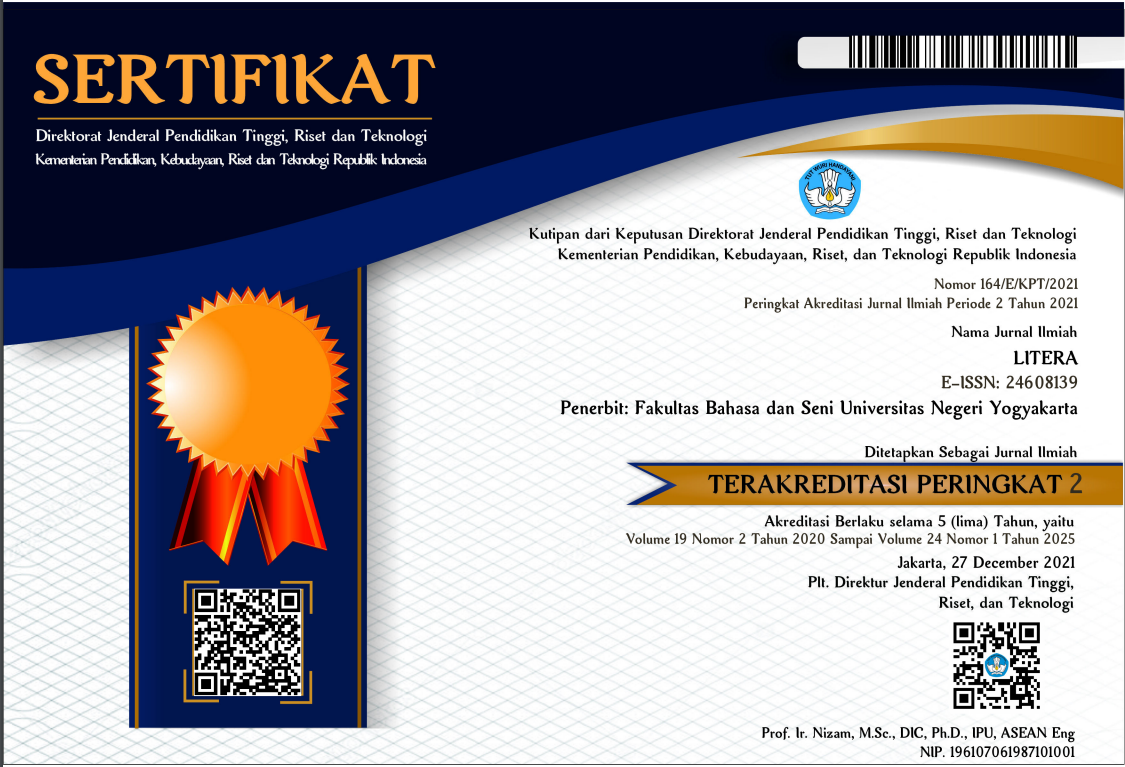THE NARRATIVE WORLD OF NATIVE AMERICANS SEEN FROM THE ADAPTATION OF OHIYESA IN BURY MY HEART AT WOUNDED KNEE
Downloads
Native American narratives are often presented through media presenting native American figures. Bury My Heart at Wounded Knee (BMHWK) is a non-fiction history-based film that tells the fate of Native Americans against white colonialism. The key figure in the film, Ohiyesa, is an adaptation of Native American figures from the The Indian Boyhood (TIB) written by Charles Eastman. This article reveals the meaning of the character Ohiyesa in the film Bury My Heart at Wounded Knee. This research used an adaptation approach. Data obtained from the exploration of the figure of Ohiyesa in TIB and BMHWK. Data analysis was performed by conducting a comparative analysis of Ohiyesa at TIB and BMHWK. The results of the analysis show: (1) Ohiyesa character was adapted and dominantly raised by the name of Charles Eastman, (2) this character revealed the memory of deprivation of Native American culture, (3) the character functioned as an assimilation agent, and voiced the concept of cultural assimilation by white Americans. Ohiyesa was made an assimilation agent by the American government. With a strong presentation through his success through his role as a doctor and lobbyist, the American government offers a new life expectancy to American society, which is a cultural assimilation. Ohiyesa has become a symbol of the helplessness and evaluation of the future of Native Americans.
Keywords: ohiyesa, native American, narrative, symbol of the helplessness,
DUNIA NARATIF PRIBUMI AMERIKA DILIHAT DARI ADAPTASI OHIYESA DALAM BURY MY HEART AT WOUNDED KNEE
Abstrak
Narasi terkait pribumi Amerika sering dimainkan melalui media yang menyuguhkan tokoh pribumi Amerika. Bury My Heart at Wounded Knee (BMHWK) merupakan film berbasis buku historical non fiction yang menceritakan nasib pribumi Amerika melawan kolonialisasi kulit putih. Tokoh kunci dalam film tersebut, Ohiyesa, merupakan adaptasi tokoh pribumi Amerika dari teks The Indian Boyhood (TIB) karya Charles Eastman. Artikel ini mengungkap pemaknaan terhadap tokoh Ohiyesa dalam film Bury My Heart at Wounded Knee. Penelitian ini menggunakan pendekatan adaptasi. Data didapatkan dari eksplorasi tokoh Ohiyesa dalam TIB dan BMHWK. Analisis data dilakukan dengan membandingkan Ohiyesa dalam TIB and BMHWK. Hasil analisis menunjukan bahwa: (1) Karakter Ohiyesa diadaptasi dan secara dominan dimunculkan dengan nama Charles Eastman, (2) Karakter ini mengungkap mengungkap memori perampasan budaya pribumi Amerika, (3) karakter tersebut difungsikan sebagai agen asimilasi, dan menyuarakan konsep asimilasi budaya oleh kulit putih Amerika. Ohiyesa dijadikan agen asimilasi oleh pemerintah Amerika. Dengan pemaparan kuat melalui keberhasilan dia melalui perannya sebagai dokter sekailgus pelobi parlemen, pemerintah Amerika menawarkan harapan hidup baru kepada pribumi Amerika, yaitu sebuah asimilasi budaya. Ohiyesa telah menjadi simbol dari ketakberdayaan dan gambaran masa depan pribumi Amerika.
Kata kunci: Ohiyesa, pribumi Amerika, narasi, simbol ketakberdayaan
Basham, M. (2012). Unmasking Tonto: Can Title vii "make it" in Hollywood? American Indian Law Review, 37(2), pp. 549-596 http://digitalcommons.law.ou.edu/ailr/vol37/iss2/5.
Bhabha, H.K. (2000). Nation and Narration, London and New York: Routledge.
Borer, M. I. (2010). From Collective Memory to Collective Imagination: Time, Place, and Urban Redevelopment. Symbolic Interaction, 33(1), pp. 96-114. https://doi.org/10.1525/si.2010.33.1.96.
Cothran, B. (2015). Enduring legacy: U.S.-Indigenous Violence and The Making of American Innocence in The Gilded Age. The Journal of the Gilded Age and Progressive Era, 14(4), pp. 562-573. DOI: 10.1017/S1537781415000377.
Eastman, C. A. (1904). Indian Boyhood. New York: McClure, Phillips.
Harris, J. (2010). "Old Norse Memorial Discourse between Orality and Literacy" in Along the Oral-Written Continuum: Types of Texts, Relations, and Their Implications Utrecht Studies in Medieval Literacy, 20. Turnhout: Brepols. https://doi.org/10.1484/M.USML-EB.6.09070802050003050304000707.
Harjo, J & Gloria, B. eds. (1997). Reinventing the Enemy's Language: Contemporary Native Women's Writing of North America. New York: WW Norton.
Hermann, P. (2013) Saga Literature, Cultural Memory and Storage. Scandinavian Studies 85(3) doi:10.1353/scd.2013.0043.
Ferry, M. L. (2009). The Thin Red Line: Native American Culture Bearers, Memory and the Museum (Order No. 3379464). Available from ProQuest Dissertations & Theses Global. (304853401). Retrieved from https://search.proquest.com/docview/304853401?accountid=17242.
Fixico, D. (2009). American Indian History and Writing from Home: Constructing an Indian Perspective. American Indian Quarterly, 33(4), 553-560. Retrieved June 8, 2020, from www.jstor.org/stable/40388487.
Grainge, P. (2003). Memory and Popular Film. Manchester: Manchester University Press
Iverson, P. (2001). The Road to Reappearance: American Indian History Since 1890. Montana; the Magazine of Western History, 51(4), 72. Retrieved from https://search.proquest.com/docview/217953230?accountid=17242.
Jacoby, K. (2008). Shadows at Dawn: A Borderlands Massacre and the Violence of History. New York: Penguin Press.
Prucha,F.P (1972). Dee Brown. Bury My Heart at Wounded Knee: An Indian History of the American West. New York: Holt, Rinehart and Winston. 1970. Pp. xvii, 487., The American Historical Review, Volume 77, Issue 2, April 1972, Pages 589–590, https://doi.org/10.1086/ahr/77.2.589.
Richardson, M. I. (2005). Constructing two cultural realities: Newspaper coverage of two american indian protest events (Order No. 3188597). Available from ProQuest Dissertations & Theses Global. (305432151). Retrieved from https://search.proquest.com/docview/305432151?accountid=17242.
Poole, R. (2008). Memory, Responsibility, and Identity. Social Research, 75(1), 263-286. Retrieved July 1, 2020, from www.jstor.org/stable/40972060.
Slotkin, R. (2000). Regeneration through Violence: The Mythology of the American Frontier, 1600-1860 . Norman: University of Oklahoma Press.
Wiersma, J.M. (2001). Politics of The Past: The Use of Abuse of History. Renner Institute.
Yves S and Daniel G, (2007). Bury My Heart at Wounded Knee, HBO Films, DVD.





















